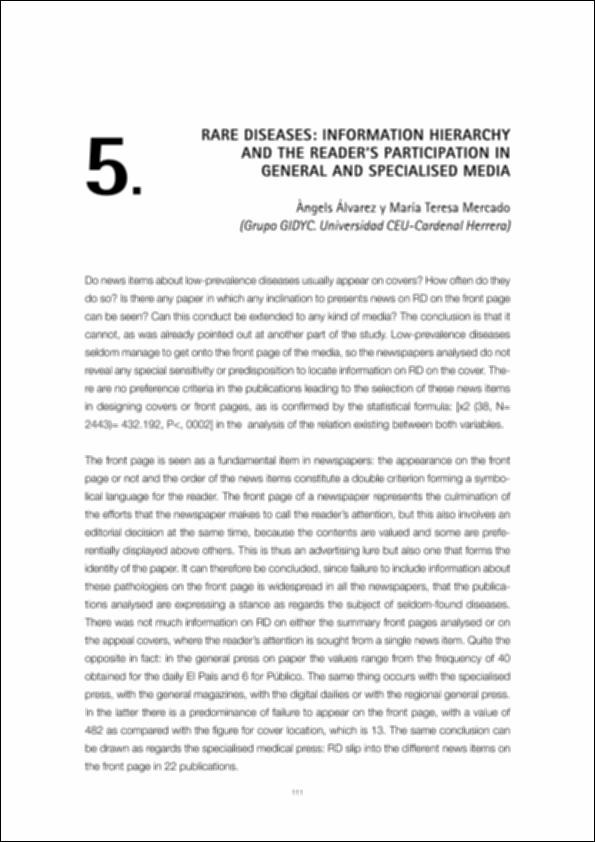Por favor, use este identificador para citar o enlazar este ítem:
http://hdl.handle.net/10637/7803Rare diseases : information hierarchy and the reader's participation in general and specialised media
| Título : | Rare diseases : information hierarchy and the reader's participation in general and specialised media |
| Otros títulos: | Communications strategies and challenges for rare diseases : medical research as a referent : a quantitative-discursive study of Spanish printed and digital written press (2009-2010) |
| Autor : | Mercado Sáez, María Teresa. Álvarez Villa, Àngels |
| Materias: | Mundo, El (Newspaper) - Content analysis - Spain.; País, El (Newspaper) - Content analysis - Spain.; ABC (Newspaper) - Content analysis - Spain.; ABC (Periódico) - Análisis de contenido - España.; País, El (Periódico) - Análisis de contenido - España.; Mundo, El (Periódico) - Análisis de contenido - España.; Vanguardia, La (Periódico) - Análisis de contenido - España.; Vanguardia, La (Newspaper) - Content analysis - Spain.; Público (Periódico) - Análisis de contenido - España.; Público (Newspaper) - Content analysis - Spain.; Periódico de Cataluña, El (Newspaper) - Content analysis - Spain.; Press - Conten analysis - Spain.; Géneros periodísticos - España.; Enfermedades raras - España.; Rare diseases - Spain.; Periódicos - Análisis de contenido - España.; Newspapers - Content analysis - Spain.; Newspapers - Sections, columns, etc. - Spain.; Prensa - Análisis de contenido - España. |
| Editorial : | Centre for Biomedical Network Research on Rare Diseases (CIBERER). |
| Citación : | Álvarez, À. y Mercado, M.T. (2011). "Rare diseases : information hierarchy and the reader's participation in general and specialised media". Bañón Hernández, A.M., Fornieles Alcaraz, J., Solves Almela, J.A. y Rius Sanchis, I. (coords.). Communications strategies and challenges for rare diseases : medical research as a referent : a quantitative-discursive study of Spanish printed and digital written press (2009-2010) (pp. 111-126). Valencia : Centre for Biomedical Network Research on Rare Diseases (CIBERER), 2011. |
| Resumen : | Do news items about low-prevalence diseases usually appear on covers? How often do they do so? Is there any paper in which any inclination to presents news on RD on the front page can be seen? Can this conduct be extended to any kind of media? The conclusion is that it cannot, as was already pointed out at another part of the study. Low-prevalence diseases seldom manage to get onto the front page of the media, so the newspapers analysed do not reveal any special sensitivity or predisposition to locate information on RD on the cover. There are no preference criteria in the publications leading to the selection of these news items in designing covers or front pages, as is confirmed by the statistical formula: [x2 (38, N= 2443)= 432.192, P<, 0002] in the analysis of the relation existing between both variables. |
| URI : | http://hdl.handle.net/10637/7803 |
| Derechos: | http://creativecommons.org/licenses/by-nc-nd/4.0/deed.es |
| ISBN : | 9788469405956. |
| Fecha de publicación : | 1-ene-2011 |
| Centro : | Universidad Cardenal Herrera-CEU |
| Aparece en las colecciones: | Dpto. Comunicación e Información Periodística |
Los ítems de DSpace están protegidos por copyright, con todos los derechos reservados, a menos que se indique lo contrario.


